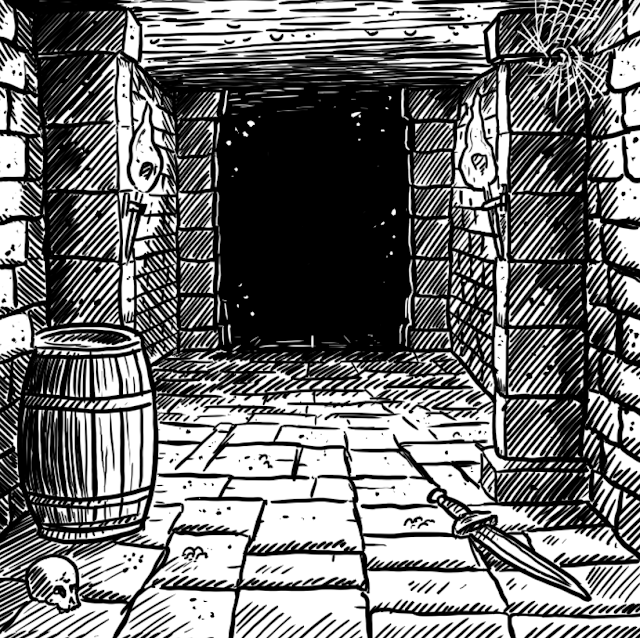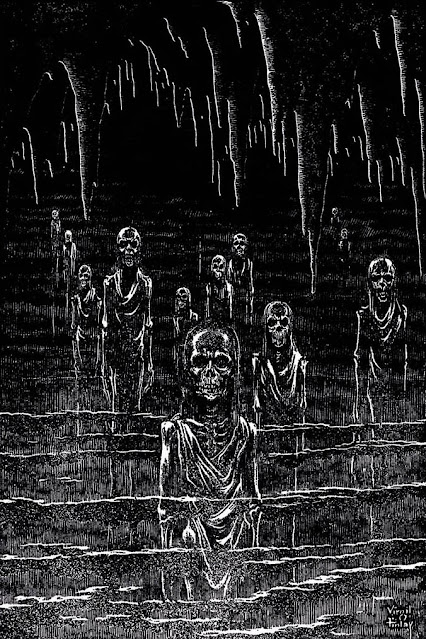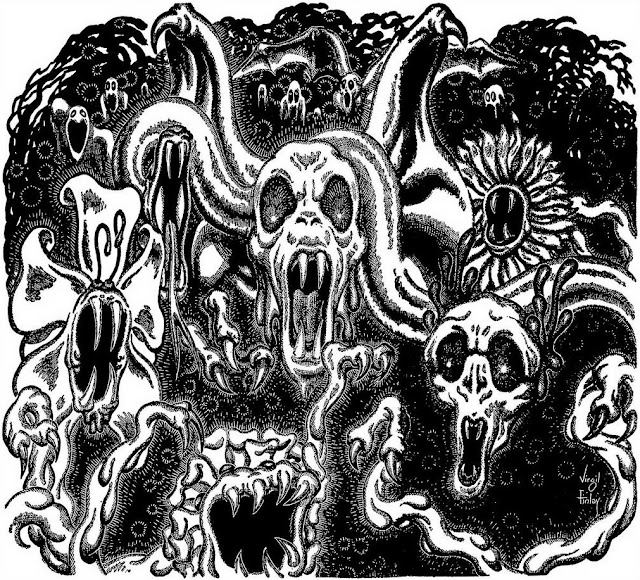Miskatonic Monday #169: Hometown Horrors, Volume 1
—oOo—
 Hometown Horrors, Volume 1: A Collection of Unique Locationsfor Call of Cthulhu is an interesting attempt to do something different for the Miskatonic Repository, the community content programme for Chaosium’ Inc.’s Callof Cthulhu, Seventh Edition. The majority of the releases on the Miskatonic Repository have consisted of scenarios, many of them horror one-shots, typically set in the roleplaying game’s default period of the Jazz Age or in the here and now of the modern day. Behind its superb subversion of Edward Hopper’s Nighthawks, some fifteen contributors to the Miskatonic Repository take us on a visit to their hometowns and each give a little bit of their histories, their oddities, their personalities, and more. These take the reader from east to west from Martha’s Vineyard on Cape Cod on the Atlantic Coast to Decatur, Tennessee, and from north to south, from across the border in Montreal, Canada to across the Gulf of Mexico, and the capital of Cuba, Havana. Presented as reports of some redacted team from the Archives and Research Division of the US Department of Defense, the anthology takes the reader to places both familiar and unfamiliar and puts some of their hometown’s secrets on show, all ready for the Keeper t o develop, whether she wants a mystery that can intrigue her players and their Investigators as they pass through or a tale of horror that will entice them to visit the towns properly.
Hometown Horrors, Volume 1: A Collection of Unique Locationsfor Call of Cthulhu is an interesting attempt to do something different for the Miskatonic Repository, the community content programme for Chaosium’ Inc.’s Callof Cthulhu, Seventh Edition. The majority of the releases on the Miskatonic Repository have consisted of scenarios, many of them horror one-shots, typically set in the roleplaying game’s default period of the Jazz Age or in the here and now of the modern day. Behind its superb subversion of Edward Hopper’s Nighthawks, some fifteen contributors to the Miskatonic Repository take us on a visit to their hometowns and each give a little bit of their histories, their oddities, their personalities, and more. These take the reader from east to west from Martha’s Vineyard on Cape Cod on the Atlantic Coast to Decatur, Tennessee, and from north to south, from across the border in Montreal, Canada to across the Gulf of Mexico, and the capital of Cuba, Havana. Presented as reports of some redacted team from the Archives and Research Division of the US Department of Defense, the anthology takes the reader to places both familiar and unfamiliar and puts some of their hometown’s secrets on show, all ready for the Keeper t o develop, whether she wants a mystery that can intrigue her players and their Investigators as they pass through or a tale of horror that will entice them to visit the towns properly. Hometown Horrors, Volume 1: A Collection of Unique Locations opens with a visit to the Jersey Shore, taking the reader along the boardwalk of Atlantic City to the infamous sideshow display called the ‘Infantorium’ which puts premature babies on show and then off the coast to suffer a rash of sharks (or is that something bigger?) or deal with some of the strange dealers of prohibition booze on Rum Row. In land, of course, the Pine Barrens are dark and inhospitable, its inhabitants unfriendly to outsiders. Then of course, there is the danger of the Jersey Devil—whatever that is… There is no explanation or indeed stats for William McCoy, this entry’s notable NPC, a real-life figure who built yachts that were much sought after by the gin runners. Locust Valley, New York is popular with the wealthy, and if invited perhaps an Investigator might suffer a strange experience at a séance or stay at the hotel run by ‘The Largest Man in America’, a friendly ready to spill the gossip—with a drink or two inside him. Binghamton, New York is the hometown of Rod Serling as well as New York State Inebriate Asylum which would later become a mental asylum and the Endicott Johnson Shoe Company which brought prosperity to the town as well as the carousels it is also famous for! Hometown Horrors, Volume 1: A Collection of Unique Locations proceeds like this through location after location, often offering interesting snippets, such as ‘The Blue Eyed Six’, the half dozen took out insurance on a neighbour in Harrisburg, Pennsylvania, and conspired to kill him when he did not die soon enough and it is reported that pairs of blue eyes have been seen floating near where the victim was buried. Just what are the eyes? Plus of course, Harrisburg, Pennsylvania is home to Three Mile Island, the site of the nuclear power station which infamously suffered a partial meltdown in 1979 and shutdown. What if the sensors indicate that it has started again? There are lots of these little snippets throughout the descriptions of Hometown Horrors, Volume 1: A Collection of Unique Locations.
Unfortunately, Hometown Horrors, Volume 1: A Collection of Unique Locations is just not enough by any measure. Every entry for every town or city is too short. A single page is not enough to cover a town’s geography and history, let alone its legends or folklore. Add in a notable personality, rumours, or a story hook and the treatment of too many of these aspects for each of the locations amounts to a paragraph. It is simply not enough information for the Keeper to use without doing a lot of further research and again, in just too many cases, the Keeper could have discovered what is in these pages by conducting her own research. It does not help that once past the history of each of these locations, the entries are inconsistent. All include one or more rumours, but some just that, and some notable NPCs or scenario hooks. Plus the rumours, the scenario hooks, and the notable NPCs vary in period between the seventh century, the Purple Age, the Jazz Age, the Modern Day, and in between, so whilst Hometown Horrors, Volume 1: A Collection of Unique Locations covers a lot of historical ground, it can never quite settle in one period long enough to be of use. The rumours, the notable NPCs, the hooks, and so on, are succinctly described at best.
Consequently, the brevity of the writing and the constraints of space leave many of the authors’ ideas as no more than hints or objects of interest rather than something that is potentially gameable. On almost every page, the reader is left to respond with, “Yes, and…?”, and wonder what ideas the authors had in mind. There is also relatively little attempt to connect any of the mysteries or oddities with the Mythos, but then the authors have almost no space to do that, just as they no space to present the folkloric or even just local horror that they hint at again and again. One more page for every entry would be a good start, but two or three extra pages of developed content would add depth and detail, as well as room for gameable content.
Physically, Hometown Horrors, Volume 1: A Collection of Unique Locations is very nicely presented, with lots of period photographs and a clean layout. It does need a strong edit in places.
Hometown Horrors, Volume 1: A Collection of Unique Locations is an intriguing introduction to a tome of local, often small town, mysteries and rumours and folklore that will provide the Keeper with an array of scenario hooks and ideas once it is finished. Until that happens, Hometown Horrors, Volume 1: A Collection of Unique Locations is a great concept that promises much, but offers only a set of place and placeholder pitches for the bigger, better, and more beguiling book it could have been.





























